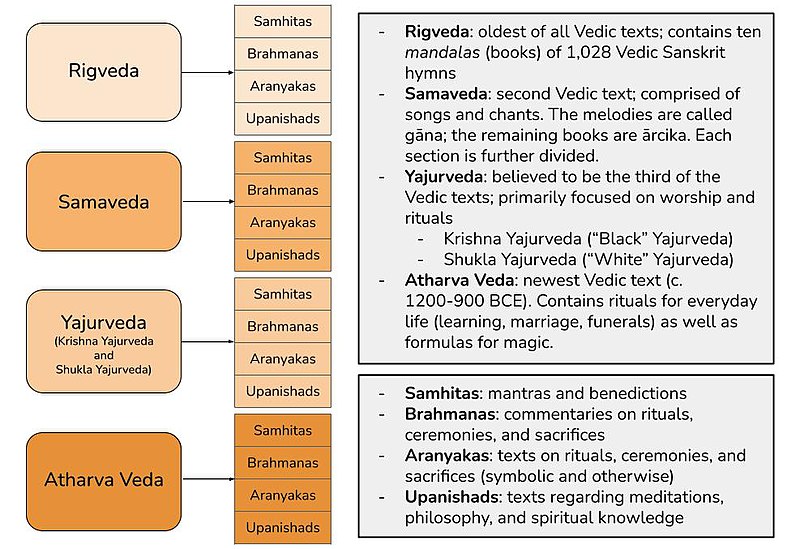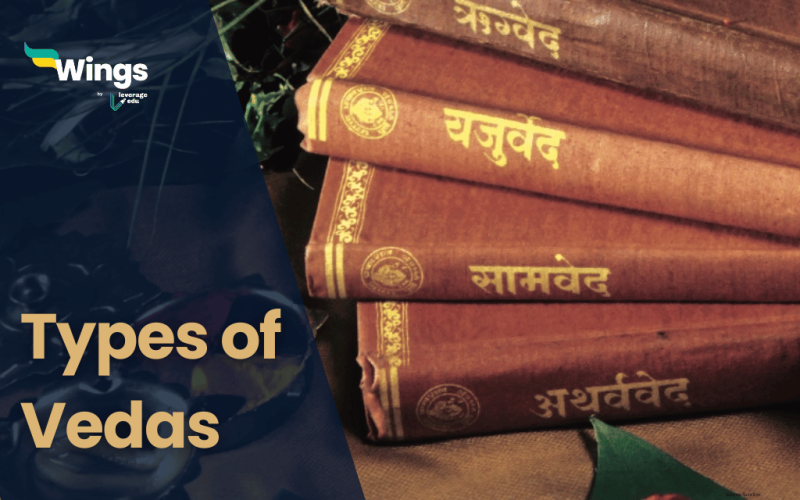Vedas are not only the revered and sacred texts of Classical Hinduism but also the only historical evidence of the Vedic period in ancient India. They are believed to be the principles of life dictated by God himself and hence, have a great influence on the culture, lifestyle and beliefs of the people. The Brahminical literature also involves the Brahmanas, Aranyakas, and Upanishads apart from the Vedas. The Vedas were verbally propagated for a long time before their documentation. There are four types of Vedas, namely, Rigveda, Samveda, Yajurveda and Atharvaveda.
Table of Contents

Rigveda
Rigveda implies knowledge of the verses. It is the oldest form of Veda and possesses a collection of 10,600 hymns. These hymns address countless Hindu deities like Lord Indra, Agni, Soma etc. Here are some more important features of Rigveda;
Features of Rigveda
- Hymns of Rigveda are also about the creation of the universe, the nature of reality and the afterlife.
- The texts are found in the earliest known Vedic Sanskrit text used between 1800 and 1100 BCE.
- The Rigveda consists of 10 books known as the Mandalas.
- Subjects like societal virtues, charity in society and other philosophical topics are also dealt with in this Veda.
- Moreover, the hymns are composed in a variety of meters and styles.
Importance of the Rigveda
- It is a valuable source of knowledge on Indo-Aryan civilisation.
- It has details about the cultural and religious beliefs of India and the practices involved during the Vedic period.
- This Veda also sheds light on the social and political structures of that society.
- It contributed majorly to the development of Hinduism. Moreover, it provides evidence of the early development of the Hindu pantheon of gods and goddesses.
- It defines the ethical and moral code of ideal human behaviour.
Also Read: Gurukul Education System in Ancient India
Samveda
Samveda is the Veda of melody and chants. It is dedicated to public worship and contains around 1549 verses.
Features of Samveda
- The Samveda is divided into Ganas and Archika. Here Gana means Chants and Archika means Verses.
- Ganas are affiliated with music, they are also used in many Vedic rituals.
- Due to the knowledge of Ganas in it, the Samveda is also considered the foundation of Indian classical music.
- On the other hand, the verses of Archika are great insights into Vedic rituals.
Importance of Samveda
- The theory and early practices of Indian classical music are based on Samveda.
- Music scholars and musicians continue to take inspiration and reference from Samveda.
- The musical notations in this scripture are the earliest known ones in the world. Moreover, it is also an inspiration for the development of early instruments like Veena and Flute.
- It talks about the Vedic concepts of ‘Rasa’ evoked by dance, music and other art forms.
- The development of Bhakti music or Qawwali is also influenced by Samveda.
Also Read: Life & Accomplishments of Aurangzeb: The Least Favorite Mughal
Yajurveda
The implication of the third Veda is to worship knowledge. It dates back to the 1100-800 BCEIt mostly contains chants for Yagya. Here are some important points to consider about it;
Features of Yajurveda
- Yajurveda is divided into Krishna Yajurveda and Shukla Yajurveda.
- Out of the two, Krishna Yajurveda is older and contains many Mantras and Brahmanas in a mixed text.
- In the newer half of this Veda, there is a clear separation between the Mantras and Brahmanas.
- Not only this, the Yajurveda also contains a variety of other texts too, these include, prose formulas and ritual instructions.
- This Veda is primarily used to perform Vedic rituals and Yagya, for instance, the soma sacrifice and the agnihotra are a few of them.
- This is why it is considered the most important Veda.
Importance of Yajurveda
- Yajurveda has detailed instructions on a wide range of Vedic rituals. It also provides insights into the symbolism and meaning of the rituals.
- It is the influence of the various Hindu rituals that are prevalent to date.
- It also offers detailed information on various sacrifices.
- This epic text also provides details on the societal concepts of Hinduism like the concept of Brahman, which is considered the ultimate reality in Hinduism.
Also Read: Khilji Dynasty (1290–1320): UPSC Notes on Origin, Reign & Succession
Atharvaveda
It loosely translates to the knowledge of a sage. The ‘tatpurush’ is for Atharvan, an ancient sage and knowledge for Veda. This Veda also dates back to 1000-800 BCE. Let’s explore some features and the importance of this Veda.
Features of Atharvaveda
- Atharvaveda elaborates on the daily procedures of one’s life.
- It is the fourth and the last of the Vedas and is segregated into 20 books.
- There are 730 hymns or suktas and 6000 mantras in these books.
- The hymns mentioned in this Veda are on diverse topics like healing, magic, philosophy, and cosmology.
- Atharvaveda is basically divided into the Bhaishajya Samhita or hymns on healing and the Atharvana Samhita which contains hymns on other topics.
- Bhaijasya Samhita is the oldest medical text owned by India and contains medicinal properties of various herbs and plants.
- However, Atharvaveda is more interesting as it has hymns on magic, spells and incantations.
- It also has three Upanishads, the Mundaka Upanishad, the Mandukya Upanishad, and the Prashna Upanishad.
Importance of Atharvaveda
- The early development of Indian medicine and magic is attributed to Atharvaveda.
- There is a deep insight into Vedic cosmology and philosophy in Atharvaveda.
- Magic is Atharvaveda is used by people to ward off evil and help them achieve their worldly goals.
- Hindu tantra is based on the use of mantras, yantras, and mudras and all of these are also elaborated in the Atharvaveda.
- This Veda also talks about the social and political structure of the Vedic society.
Relevant Blogs
These were the four types of Vedas along with their features and importance to society from the ancient age till now. For more such informative blogs on Indian History stay tuned to our General Knowledge section.
 One app for all your study abroad needs
One app for all your study abroad needs













